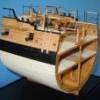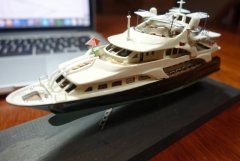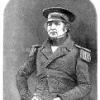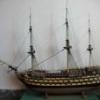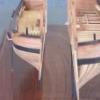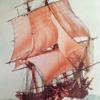-
Posts
629 -
Joined
-
Last visited
Reputation Activity
-
 kruginmi got a reaction from Chuck Seiler in HMS Druid by kruginmi - 1:48 - cross-section - Hahn
kruginmi got a reaction from Chuck Seiler in HMS Druid by kruginmi - 1:48 - cross-section - Hahn
So after finally settling down on understanding the number and type of lines, I can move into the job of estimating what type of work I have in front of me with regards to blocks. Currently I am showing 132 blocks are needed for this cross section (wow). For the basic type (single and double) there are:
So you can see the actual ship had 12 varieties of these from 5" to 20". For the model on a first pass I am looking at cutting this down to 8 types from 1/8" to 3/8". So, for example, the 5, 6 and 7 inch single blocks are combined to the 1/8" scale block. The question now is whether or not I should combine more, to like three of each type. Feedback welcome.
For the rest of the blocks, the numbers are much smaller (besides the dead eyes):
There are one offs that I can think about actually making without going a little crazy. Still need to go over the blocks again and am sure to add more - the biggest mistake I keep making is to double shown quantities to account for port and starboard.
Really enjoying the process, hope to start building again soon!
Mark
-
 kruginmi got a reaction from dvm27 in HMS Druid by kruginmi - 1:48 - cross-section - Hahn
kruginmi got a reaction from dvm27 in HMS Druid by kruginmi - 1:48 - cross-section - Hahn
So after finally settling down on understanding the number and type of lines, I can move into the job of estimating what type of work I have in front of me with regards to blocks. Currently I am showing 132 blocks are needed for this cross section (wow). For the basic type (single and double) there are:
So you can see the actual ship had 12 varieties of these from 5" to 20". For the model on a first pass I am looking at cutting this down to 8 types from 1/8" to 3/8". So, for example, the 5, 6 and 7 inch single blocks are combined to the 1/8" scale block. The question now is whether or not I should combine more, to like three of each type. Feedback welcome.
For the rest of the blocks, the numbers are much smaller (besides the dead eyes):
There are one offs that I can think about actually making without going a little crazy. Still need to go over the blocks again and am sure to add more - the biggest mistake I keep making is to double shown quantities to account for port and starboard.
Really enjoying the process, hope to start building again soon!
Mark
-
 kruginmi got a reaction from mtaylor in HMS Druid by kruginmi - 1:48 - cross-section - Hahn
kruginmi got a reaction from mtaylor in HMS Druid by kruginmi - 1:48 - cross-section - Hahn
So after finally settling down on understanding the number and type of lines, I can move into the job of estimating what type of work I have in front of me with regards to blocks. Currently I am showing 132 blocks are needed for this cross section (wow). For the basic type (single and double) there are:
So you can see the actual ship had 12 varieties of these from 5" to 20". For the model on a first pass I am looking at cutting this down to 8 types from 1/8" to 3/8". So, for example, the 5, 6 and 7 inch single blocks are combined to the 1/8" scale block. The question now is whether or not I should combine more, to like three of each type. Feedback welcome.
For the rest of the blocks, the numbers are much smaller (besides the dead eyes):
There are one offs that I can think about actually making without going a little crazy. Still need to go over the blocks again and am sure to add more - the biggest mistake I keep making is to double shown quantities to account for port and starboard.
Really enjoying the process, hope to start building again soon!
Mark
-
 kruginmi got a reaction from egkb in HMS Druid by kruginmi - 1:48 - cross-section - Hahn
kruginmi got a reaction from egkb in HMS Druid by kruginmi - 1:48 - cross-section - Hahn
This is an updated partial look at my DRUID rigging details spreadsheet, centered on main mast connections. I am liking this more and more. This will be pretty standard for detailed rigging systems in the future for me:
If you read across any row you can identify all rigging lines that are accounted for and the run of the lines themselves. So, for example, the Main Yard Jeers (7" line) has a one 20" double block attached to the yard, two 20" single blocks lashed to the Main Mast Head, a double block attached on the deck by the mast then a second double block for mechanical gain, then on to a sheave in the rail prior to affixing to the pin rail.
If you read down any column, you can see what connections any one part should have. So the Main Top Gallant yard is exactly identified (all the sail work lines are farther down out of view).
I am still working through the sheet from several different angles to insure its completeness. Next steps are to identify the lay of each line and also whether any serving is required. Lots of in depth learning which is making me very comfortable with the subject matter.
mark
-
 kruginmi got a reaction from Canute in HMS Druid by kruginmi - 1:48 - cross-section - Hahn
kruginmi got a reaction from Canute in HMS Druid by kruginmi - 1:48 - cross-section - Hahn
This is an updated partial look at my DRUID rigging details spreadsheet, centered on main mast connections. I am liking this more and more. This will be pretty standard for detailed rigging systems in the future for me:
If you read across any row you can identify all rigging lines that are accounted for and the run of the lines themselves. So, for example, the Main Yard Jeers (7" line) has a one 20" double block attached to the yard, two 20" single blocks lashed to the Main Mast Head, a double block attached on the deck by the mast then a second double block for mechanical gain, then on to a sheave in the rail prior to affixing to the pin rail.
If you read down any column, you can see what connections any one part should have. So the Main Top Gallant yard is exactly identified (all the sail work lines are farther down out of view).
I am still working through the sheet from several different angles to insure its completeness. Next steps are to identify the lay of each line and also whether any serving is required. Lots of in depth learning which is making me very comfortable with the subject matter.
mark
-
 kruginmi got a reaction from Landrotten Highlander in HMS Druid by kruginmi - 1:48 - cross-section - Hahn
kruginmi got a reaction from Landrotten Highlander in HMS Druid by kruginmi - 1:48 - cross-section - Hahn
This is an updated partial look at my DRUID rigging details spreadsheet, centered on main mast connections. I am liking this more and more. This will be pretty standard for detailed rigging systems in the future for me:
If you read across any row you can identify all rigging lines that are accounted for and the run of the lines themselves. So, for example, the Main Yard Jeers (7" line) has a one 20" double block attached to the yard, two 20" single blocks lashed to the Main Mast Head, a double block attached on the deck by the mast then a second double block for mechanical gain, then on to a sheave in the rail prior to affixing to the pin rail.
If you read down any column, you can see what connections any one part should have. So the Main Top Gallant yard is exactly identified (all the sail work lines are farther down out of view).
I am still working through the sheet from several different angles to insure its completeness. Next steps are to identify the lay of each line and also whether any serving is required. Lots of in depth learning which is making me very comfortable with the subject matter.
mark
-
 kruginmi got a reaction from Omega1234 in HMS Druid by kruginmi - 1:48 - cross-section - Hahn
kruginmi got a reaction from Omega1234 in HMS Druid by kruginmi - 1:48 - cross-section - Hahn
This is an updated partial look at my DRUID rigging details spreadsheet, centered on main mast connections. I am liking this more and more. This will be pretty standard for detailed rigging systems in the future for me:
If you read across any row you can identify all rigging lines that are accounted for and the run of the lines themselves. So, for example, the Main Yard Jeers (7" line) has a one 20" double block attached to the yard, two 20" single blocks lashed to the Main Mast Head, a double block attached on the deck by the mast then a second double block for mechanical gain, then on to a sheave in the rail prior to affixing to the pin rail.
If you read down any column, you can see what connections any one part should have. So the Main Top Gallant yard is exactly identified (all the sail work lines are farther down out of view).
I am still working through the sheet from several different angles to insure its completeness. Next steps are to identify the lay of each line and also whether any serving is required. Lots of in depth learning which is making me very comfortable with the subject matter.
mark
-
 kruginmi got a reaction from mtaylor in HMS Druid by kruginmi - 1:48 - cross-section - Hahn
kruginmi got a reaction from mtaylor in HMS Druid by kruginmi - 1:48 - cross-section - Hahn
This is an updated partial look at my DRUID rigging details spreadsheet, centered on main mast connections. I am liking this more and more. This will be pretty standard for detailed rigging systems in the future for me:
If you read across any row you can identify all rigging lines that are accounted for and the run of the lines themselves. So, for example, the Main Yard Jeers (7" line) has a one 20" double block attached to the yard, two 20" single blocks lashed to the Main Mast Head, a double block attached on the deck by the mast then a second double block for mechanical gain, then on to a sheave in the rail prior to affixing to the pin rail.
If you read down any column, you can see what connections any one part should have. So the Main Top Gallant yard is exactly identified (all the sail work lines are farther down out of view).
I am still working through the sheet from several different angles to insure its completeness. Next steps are to identify the lay of each line and also whether any serving is required. Lots of in depth learning which is making me very comfortable with the subject matter.
mark
-
 kruginmi got a reaction from egkb in HMS Druid by kruginmi - 1:48 - cross-section - Hahn
kruginmi got a reaction from egkb in HMS Druid by kruginmi - 1:48 - cross-section - Hahn
Rigging, rigging, rigging. I am relatively new to the details of this subject and prior to going much farther on the masting work wanted to have a firm plan on what should be done when, specifically regarding blocks / thimbles / and collars. Before I get into the details I am working three questions with respect to this cross section:
1. Should I include rigging features that are used for the sails on the main mast, but have no termination. A good example are the braces. The pendants can be quite long and will be left dangling since the forward connection points are not present.
2. A related question are rigging features that are used for the mizzen or foremast. A good example are the mizzen stays. There are several collars on the main mast that would lead these stays to the deck below.
3. Last are the temporary used features, like the topropes for raising the topmast into place.
My initial thoughts are:
1. Include them, but shorten up the pendants so they don't stick out so much. They will be empty blocks at the end of the pendants.
2. Include them. Again, empty blocks.
3. I would like to include these for education opportunities (both for me and people looking at the model). I need to insure with all the other rigging place these can be in place.
For my education I am using TFFM - Antscherl, Rigging Period Ship Models (square rigged) - Petersson, Anatomy of the Ship (Endeavor) - Marquardt, Masting and Rigging of English Ships of War - Lee and Plans for the HMS Brilliant from the Smithsonian (prior to renaming Druid).
This is an American cargo ship converted to a British Sloop of war so there are lots of questions and deviations from any one source. The first task was to understand what rigging lines I need to handle and what they touch. This is captured in a spreadsheet still undergoing review (partially shown):
Green means there is a touch point between the line and the component listed at the top. For my sanity I split the masts into component pieces. Once complete I can look down through any column and insure every one of those touch points are handled (hopefully prior to putting on the model).
After tracing everything a couple more times and verifying them the next step will be to identify line diameters and block types and sizes (TFFM at its best). Then I will feel confident enough to proceed. My biggest issue was getting this global view. For running rigging, the diagrams 'usually' don't include the details from the standing. Something was always missing for simplicity. This spreadsheet overcomes that issue.
Lots of learning. I feel like I should re-read those Aubrey-Maturin books now, I would have a MUCH better understanding of the at sea events.
Mark
-
 kruginmi got a reaction from Erebus and Terror in HMS Druid by kruginmi - 1:48 - cross-section - Hahn
kruginmi got a reaction from Erebus and Terror in HMS Druid by kruginmi - 1:48 - cross-section - Hahn
I have spent most of my time studying rigging, but decided to produce some results. Next up was the top mast:
With the jigs and the process talked about in TFFM this wasn't too bad, and done in an evening. Truth be told it did take two tries. It is hard to see the octagonal section above the bottom square section but it is there. It should pop with some paint. It fits just snug into the main top trestle trees. The top rope sheaves or fid hole have not been cut yet.
The same process will be used for the top gallant mast, but with thinner stock. I cut the rough square stock out of basswood but think it is just a little too thin. I will use boxwood for this - as well as the topmast trestle trees. I couldn't help putting the top gallant plug in place:
The topgallant mast and associated trestle trees is the goal for this week.
Mark
-
 kruginmi got a reaction from Canute in HMS Druid by kruginmi - 1:48 - cross-section - Hahn
kruginmi got a reaction from Canute in HMS Druid by kruginmi - 1:48 - cross-section - Hahn
Rigging, rigging, rigging. I am relatively new to the details of this subject and prior to going much farther on the masting work wanted to have a firm plan on what should be done when, specifically regarding blocks / thimbles / and collars. Before I get into the details I am working three questions with respect to this cross section:
1. Should I include rigging features that are used for the sails on the main mast, but have no termination. A good example are the braces. The pendants can be quite long and will be left dangling since the forward connection points are not present.
2. A related question are rigging features that are used for the mizzen or foremast. A good example are the mizzen stays. There are several collars on the main mast that would lead these stays to the deck below.
3. Last are the temporary used features, like the topropes for raising the topmast into place.
My initial thoughts are:
1. Include them, but shorten up the pendants so they don't stick out so much. They will be empty blocks at the end of the pendants.
2. Include them. Again, empty blocks.
3. I would like to include these for education opportunities (both for me and people looking at the model). I need to insure with all the other rigging place these can be in place.
For my education I am using TFFM - Antscherl, Rigging Period Ship Models (square rigged) - Petersson, Anatomy of the Ship (Endeavor) - Marquardt, Masting and Rigging of English Ships of War - Lee and Plans for the HMS Brilliant from the Smithsonian (prior to renaming Druid).
This is an American cargo ship converted to a British Sloop of war so there are lots of questions and deviations from any one source. The first task was to understand what rigging lines I need to handle and what they touch. This is captured in a spreadsheet still undergoing review (partially shown):
Green means there is a touch point between the line and the component listed at the top. For my sanity I split the masts into component pieces. Once complete I can look down through any column and insure every one of those touch points are handled (hopefully prior to putting on the model).
After tracing everything a couple more times and verifying them the next step will be to identify line diameters and block types and sizes (TFFM at its best). Then I will feel confident enough to proceed. My biggest issue was getting this global view. For running rigging, the diagrams 'usually' don't include the details from the standing. Something was always missing for simplicity. This spreadsheet overcomes that issue.
Lots of learning. I feel like I should re-read those Aubrey-Maturin books now, I would have a MUCH better understanding of the at sea events.
Mark
-
 kruginmi got a reaction from gjdale in HMS Druid by kruginmi - 1:48 - cross-section - Hahn
kruginmi got a reaction from gjdale in HMS Druid by kruginmi - 1:48 - cross-section - Hahn
Rigging, rigging, rigging. I am relatively new to the details of this subject and prior to going much farther on the masting work wanted to have a firm plan on what should be done when, specifically regarding blocks / thimbles / and collars. Before I get into the details I am working three questions with respect to this cross section:
1. Should I include rigging features that are used for the sails on the main mast, but have no termination. A good example are the braces. The pendants can be quite long and will be left dangling since the forward connection points are not present.
2. A related question are rigging features that are used for the mizzen or foremast. A good example are the mizzen stays. There are several collars on the main mast that would lead these stays to the deck below.
3. Last are the temporary used features, like the topropes for raising the topmast into place.
My initial thoughts are:
1. Include them, but shorten up the pendants so they don't stick out so much. They will be empty blocks at the end of the pendants.
2. Include them. Again, empty blocks.
3. I would like to include these for education opportunities (both for me and people looking at the model). I need to insure with all the other rigging place these can be in place.
For my education I am using TFFM - Antscherl, Rigging Period Ship Models (square rigged) - Petersson, Anatomy of the Ship (Endeavor) - Marquardt, Masting and Rigging of English Ships of War - Lee and Plans for the HMS Brilliant from the Smithsonian (prior to renaming Druid).
This is an American cargo ship converted to a British Sloop of war so there are lots of questions and deviations from any one source. The first task was to understand what rigging lines I need to handle and what they touch. This is captured in a spreadsheet still undergoing review (partially shown):
Green means there is a touch point between the line and the component listed at the top. For my sanity I split the masts into component pieces. Once complete I can look down through any column and insure every one of those touch points are handled (hopefully prior to putting on the model).
After tracing everything a couple more times and verifying them the next step will be to identify line diameters and block types and sizes (TFFM at its best). Then I will feel confident enough to proceed. My biggest issue was getting this global view. For running rigging, the diagrams 'usually' don't include the details from the standing. Something was always missing for simplicity. This spreadsheet overcomes that issue.
Lots of learning. I feel like I should re-read those Aubrey-Maturin books now, I would have a MUCH better understanding of the at sea events.
Mark
-
 kruginmi got a reaction from Landrotten Highlander in HMS Druid by kruginmi - 1:48 - cross-section - Hahn
kruginmi got a reaction from Landrotten Highlander in HMS Druid by kruginmi - 1:48 - cross-section - Hahn
Rigging, rigging, rigging. I am relatively new to the details of this subject and prior to going much farther on the masting work wanted to have a firm plan on what should be done when, specifically regarding blocks / thimbles / and collars. Before I get into the details I am working three questions with respect to this cross section:
1. Should I include rigging features that are used for the sails on the main mast, but have no termination. A good example are the braces. The pendants can be quite long and will be left dangling since the forward connection points are not present.
2. A related question are rigging features that are used for the mizzen or foremast. A good example are the mizzen stays. There are several collars on the main mast that would lead these stays to the deck below.
3. Last are the temporary used features, like the topropes for raising the topmast into place.
My initial thoughts are:
1. Include them, but shorten up the pendants so they don't stick out so much. They will be empty blocks at the end of the pendants.
2. Include them. Again, empty blocks.
3. I would like to include these for education opportunities (both for me and people looking at the model). I need to insure with all the other rigging place these can be in place.
For my education I am using TFFM - Antscherl, Rigging Period Ship Models (square rigged) - Petersson, Anatomy of the Ship (Endeavor) - Marquardt, Masting and Rigging of English Ships of War - Lee and Plans for the HMS Brilliant from the Smithsonian (prior to renaming Druid).
This is an American cargo ship converted to a British Sloop of war so there are lots of questions and deviations from any one source. The first task was to understand what rigging lines I need to handle and what they touch. This is captured in a spreadsheet still undergoing review (partially shown):
Green means there is a touch point between the line and the component listed at the top. For my sanity I split the masts into component pieces. Once complete I can look down through any column and insure every one of those touch points are handled (hopefully prior to putting on the model).
After tracing everything a couple more times and verifying them the next step will be to identify line diameters and block types and sizes (TFFM at its best). Then I will feel confident enough to proceed. My biggest issue was getting this global view. For running rigging, the diagrams 'usually' don't include the details from the standing. Something was always missing for simplicity. This spreadsheet overcomes that issue.
Lots of learning. I feel like I should re-read those Aubrey-Maturin books now, I would have a MUCH better understanding of the at sea events.
Mark
-
 kruginmi got a reaction from mtaylor in HMS Druid by kruginmi - 1:48 - cross-section - Hahn
kruginmi got a reaction from mtaylor in HMS Druid by kruginmi - 1:48 - cross-section - Hahn
Rigging, rigging, rigging. I am relatively new to the details of this subject and prior to going much farther on the masting work wanted to have a firm plan on what should be done when, specifically regarding blocks / thimbles / and collars. Before I get into the details I am working three questions with respect to this cross section:
1. Should I include rigging features that are used for the sails on the main mast, but have no termination. A good example are the braces. The pendants can be quite long and will be left dangling since the forward connection points are not present.
2. A related question are rigging features that are used for the mizzen or foremast. A good example are the mizzen stays. There are several collars on the main mast that would lead these stays to the deck below.
3. Last are the temporary used features, like the topropes for raising the topmast into place.
My initial thoughts are:
1. Include them, but shorten up the pendants so they don't stick out so much. They will be empty blocks at the end of the pendants.
2. Include them. Again, empty blocks.
3. I would like to include these for education opportunities (both for me and people looking at the model). I need to insure with all the other rigging place these can be in place.
For my education I am using TFFM - Antscherl, Rigging Period Ship Models (square rigged) - Petersson, Anatomy of the Ship (Endeavor) - Marquardt, Masting and Rigging of English Ships of War - Lee and Plans for the HMS Brilliant from the Smithsonian (prior to renaming Druid).
This is an American cargo ship converted to a British Sloop of war so there are lots of questions and deviations from any one source. The first task was to understand what rigging lines I need to handle and what they touch. This is captured in a spreadsheet still undergoing review (partially shown):
Green means there is a touch point between the line and the component listed at the top. For my sanity I split the masts into component pieces. Once complete I can look down through any column and insure every one of those touch points are handled (hopefully prior to putting on the model).
After tracing everything a couple more times and verifying them the next step will be to identify line diameters and block types and sizes (TFFM at its best). Then I will feel confident enough to proceed. My biggest issue was getting this global view. For running rigging, the diagrams 'usually' don't include the details from the standing. Something was always missing for simplicity. This spreadsheet overcomes that issue.
Lots of learning. I feel like I should re-read those Aubrey-Maturin books now, I would have a MUCH better understanding of the at sea events.
Mark
-
 kruginmi got a reaction from Omega1234 in HMS Druid by kruginmi - 1:48 - cross-section - Hahn
kruginmi got a reaction from Omega1234 in HMS Druid by kruginmi - 1:48 - cross-section - Hahn
Rigging, rigging, rigging. I am relatively new to the details of this subject and prior to going much farther on the masting work wanted to have a firm plan on what should be done when, specifically regarding blocks / thimbles / and collars. Before I get into the details I am working three questions with respect to this cross section:
1. Should I include rigging features that are used for the sails on the main mast, but have no termination. A good example are the braces. The pendants can be quite long and will be left dangling since the forward connection points are not present.
2. A related question are rigging features that are used for the mizzen or foremast. A good example are the mizzen stays. There are several collars on the main mast that would lead these stays to the deck below.
3. Last are the temporary used features, like the topropes for raising the topmast into place.
My initial thoughts are:
1. Include them, but shorten up the pendants so they don't stick out so much. They will be empty blocks at the end of the pendants.
2. Include them. Again, empty blocks.
3. I would like to include these for education opportunities (both for me and people looking at the model). I need to insure with all the other rigging place these can be in place.
For my education I am using TFFM - Antscherl, Rigging Period Ship Models (square rigged) - Petersson, Anatomy of the Ship (Endeavor) - Marquardt, Masting and Rigging of English Ships of War - Lee and Plans for the HMS Brilliant from the Smithsonian (prior to renaming Druid).
This is an American cargo ship converted to a British Sloop of war so there are lots of questions and deviations from any one source. The first task was to understand what rigging lines I need to handle and what they touch. This is captured in a spreadsheet still undergoing review (partially shown):
Green means there is a touch point between the line and the component listed at the top. For my sanity I split the masts into component pieces. Once complete I can look down through any column and insure every one of those touch points are handled (hopefully prior to putting on the model).
After tracing everything a couple more times and verifying them the next step will be to identify line diameters and block types and sizes (TFFM at its best). Then I will feel confident enough to proceed. My biggest issue was getting this global view. For running rigging, the diagrams 'usually' don't include the details from the standing. Something was always missing for simplicity. This spreadsheet overcomes that issue.
Lots of learning. I feel like I should re-read those Aubrey-Maturin books now, I would have a MUCH better understanding of the at sea events.
Mark
-
 kruginmi got a reaction from dgbot in HMS Druid by kruginmi - 1:48 - cross-section - Hahn
kruginmi got a reaction from dgbot in HMS Druid by kruginmi - 1:48 - cross-section - Hahn
Thanks everyone for stopping by!
With a bit of time I decided to tackle the top gallant mast out of a piece of boxwood. It was coming into shape pretty quick and I was liking the result when, bang, the top pole snapped off. Too much pressure / not enough support. From history I learned to take a breath (okay, I uttered some stuff first but then....) and calm down. My first instinct was to go at it with another try, but it was a shame with the first one shaping up so well.
I leaned back and laid out my options. I actually decided this was a good thing. Better snapping now then when you are pulling on the backstay and the whole assembly comes off. The wood here gets pretty thin so I decided to try something to provide some added strength. I grabbed some thin walnut dowel I had nearby and drilled in a hole for it to sit - what could I lose. With some glue and a good snug fit it didn't take too long to put in a much stronger replacement. With some more walnut I added the cap and sanded to shape. Lemonade out of lemons.
I am sorely tempted to not paint this piece and leave it as a nice capper to the mast assembly. What started out as a negative has definitely turned into a huge positive. I love this hobby.
Still some more sanding to do on the mast section itself.
Mark
-
 kruginmi got a reaction from tadheus in HMS Druid by kruginmi - 1:48 - cross-section - Hahn
kruginmi got a reaction from tadheus in HMS Druid by kruginmi - 1:48 - cross-section - Hahn
Thanks everyone for stopping by!
With a bit of time I decided to tackle the top gallant mast out of a piece of boxwood. It was coming into shape pretty quick and I was liking the result when, bang, the top pole snapped off. Too much pressure / not enough support. From history I learned to take a breath (okay, I uttered some stuff first but then....) and calm down. My first instinct was to go at it with another try, but it was a shame with the first one shaping up so well.
I leaned back and laid out my options. I actually decided this was a good thing. Better snapping now then when you are pulling on the backstay and the whole assembly comes off. The wood here gets pretty thin so I decided to try something to provide some added strength. I grabbed some thin walnut dowel I had nearby and drilled in a hole for it to sit - what could I lose. With some glue and a good snug fit it didn't take too long to put in a much stronger replacement. With some more walnut I added the cap and sanded to shape. Lemonade out of lemons.
I am sorely tempted to not paint this piece and leave it as a nice capper to the mast assembly. What started out as a negative has definitely turned into a huge positive. I love this hobby.
Still some more sanding to do on the mast section itself.
Mark
-
 kruginmi got a reaction from albert in HMS Druid by kruginmi - 1:48 - cross-section - Hahn
kruginmi got a reaction from albert in HMS Druid by kruginmi - 1:48 - cross-section - Hahn
I have spent most of my time studying rigging, but decided to produce some results. Next up was the top mast:
With the jigs and the process talked about in TFFM this wasn't too bad, and done in an evening. Truth be told it did take two tries. It is hard to see the octagonal section above the bottom square section but it is there. It should pop with some paint. It fits just snug into the main top trestle trees. The top rope sheaves or fid hole have not been cut yet.
The same process will be used for the top gallant mast, but with thinner stock. I cut the rough square stock out of basswood but think it is just a little too thin. I will use boxwood for this - as well as the topmast trestle trees. I couldn't help putting the top gallant plug in place:
The topgallant mast and associated trestle trees is the goal for this week.
Mark
-
 kruginmi reacted to Canute in HMS Druid by kruginmi - 1:48 - cross-section - Hahn
kruginmi reacted to Canute in HMS Druid by kruginmi - 1:48 - cross-section - Hahn
Great save! Another idea for that bag of "tricks".
-
 kruginmi got a reaction from egkb in HMS Druid by kruginmi - 1:48 - cross-section - Hahn
kruginmi got a reaction from egkb in HMS Druid by kruginmi - 1:48 - cross-section - Hahn
Thanks everyone for stopping by!
With a bit of time I decided to tackle the top gallant mast out of a piece of boxwood. It was coming into shape pretty quick and I was liking the result when, bang, the top pole snapped off. Too much pressure / not enough support. From history I learned to take a breath (okay, I uttered some stuff first but then....) and calm down. My first instinct was to go at it with another try, but it was a shame with the first one shaping up so well.
I leaned back and laid out my options. I actually decided this was a good thing. Better snapping now then when you are pulling on the backstay and the whole assembly comes off. The wood here gets pretty thin so I decided to try something to provide some added strength. I grabbed some thin walnut dowel I had nearby and drilled in a hole for it to sit - what could I lose. With some glue and a good snug fit it didn't take too long to put in a much stronger replacement. With some more walnut I added the cap and sanded to shape. Lemonade out of lemons.
I am sorely tempted to not paint this piece and leave it as a nice capper to the mast assembly. What started out as a negative has definitely turned into a huge positive. I love this hobby.
Still some more sanding to do on the mast section itself.
Mark
-
 kruginmi got a reaction from dvm27 in HMS Druid by kruginmi - 1:48 - cross-section - Hahn
kruginmi got a reaction from dvm27 in HMS Druid by kruginmi - 1:48 - cross-section - Hahn
Thanks everyone for stopping by!
With a bit of time I decided to tackle the top gallant mast out of a piece of boxwood. It was coming into shape pretty quick and I was liking the result when, bang, the top pole snapped off. Too much pressure / not enough support. From history I learned to take a breath (okay, I uttered some stuff first but then....) and calm down. My first instinct was to go at it with another try, but it was a shame with the first one shaping up so well.
I leaned back and laid out my options. I actually decided this was a good thing. Better snapping now then when you are pulling on the backstay and the whole assembly comes off. The wood here gets pretty thin so I decided to try something to provide some added strength. I grabbed some thin walnut dowel I had nearby and drilled in a hole for it to sit - what could I lose. With some glue and a good snug fit it didn't take too long to put in a much stronger replacement. With some more walnut I added the cap and sanded to shape. Lemonade out of lemons.
I am sorely tempted to not paint this piece and leave it as a nice capper to the mast assembly. What started out as a negative has definitely turned into a huge positive. I love this hobby.
Still some more sanding to do on the mast section itself.
Mark
-
 kruginmi reacted to Omega1234 in HMS Druid by kruginmi - 1:48 - cross-section - Hahn
kruginmi reacted to Omega1234 in HMS Druid by kruginmi - 1:48 - cross-section - Hahn
Hi Mark
Sometimes it's amazing how much good fortune can come out of a simple mistake.
Good turn around, for sure!
Cheers
Patrick
-
 kruginmi got a reaction from Canute in HMS Druid by kruginmi - 1:48 - cross-section - Hahn
kruginmi got a reaction from Canute in HMS Druid by kruginmi - 1:48 - cross-section - Hahn
Thanks everyone for stopping by!
With a bit of time I decided to tackle the top gallant mast out of a piece of boxwood. It was coming into shape pretty quick and I was liking the result when, bang, the top pole snapped off. Too much pressure / not enough support. From history I learned to take a breath (okay, I uttered some stuff first but then....) and calm down. My first instinct was to go at it with another try, but it was a shame with the first one shaping up so well.
I leaned back and laid out my options. I actually decided this was a good thing. Better snapping now then when you are pulling on the backstay and the whole assembly comes off. The wood here gets pretty thin so I decided to try something to provide some added strength. I grabbed some thin walnut dowel I had nearby and drilled in a hole for it to sit - what could I lose. With some glue and a good snug fit it didn't take too long to put in a much stronger replacement. With some more walnut I added the cap and sanded to shape. Lemonade out of lemons.
I am sorely tempted to not paint this piece and leave it as a nice capper to the mast assembly. What started out as a negative has definitely turned into a huge positive. I love this hobby.
Still some more sanding to do on the mast section itself.
Mark
-
 kruginmi got a reaction from CharlieZardoz in HMS Druid by kruginmi - 1:48 - cross-section - Hahn
kruginmi got a reaction from CharlieZardoz in HMS Druid by kruginmi - 1:48 - cross-section - Hahn
To use a phrase from Monty Python: 'Not dead yet.' Slow but sure the new frames have been generated. Everything triple checked and locked in. This morning I glued the framework to the base jig (excepting first and last frames) and everything is in its proper place:
I need to add the walnut chocks to the 18th and 27th frames prior to gluing those in and then fair the hull. The hull is already so close to being smooth, which is how it should be. Shouldn't take too much effort.
I did add removable spacer blocks (in the pics) at the mid-points either side and will probably not add spacer blocks. Once the mid-section is good to go I will add the wales for strength.
One other difference from previous attempts was to get all the frames in place insuring everything measured out correctly before gluing anything. I only added glue once in place and pushed it around where the frame and the bottom jig intersected. No chance of it grabbing prior to being in its final place.
Mark
-
 kruginmi got a reaction from CharlieZardoz in HMS Druid by kruginmi - 1:48 - cross-section - Hahn
kruginmi got a reaction from CharlieZardoz in HMS Druid by kruginmi - 1:48 - cross-section - Hahn
Final push to get the lower hold planks in place - the 1/16" basswood ones. I couldn't leave it so close to getting buttoned up so I spent most of the day going back and forth. The old: cut, glue and clamp two planks (one each side), wait to dry, remove and do the next two. Pretty straight forward stuff. I opted to only use planks that traversed the whole cross section. There will be so much stuff down here (eventually) I didn't think anyone would be able to notice any different later.
So yet another couple of shots showing the hold:
No smooth surface going up the walls here. I realize it would be pretty easy to climb up the walls without any further assist. Still some tidying up to do here and there.
Making that mast footing is going to take some time, but that is for another day. Probably need to make some berth deck beams, if not orlop ones to start figuring out bulkheads and the well. The cross section definitely feels pretty solid now!
Mark




